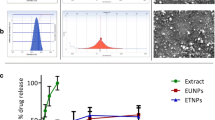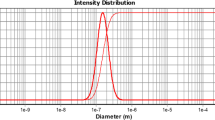Abstract
The underlying mechanism involved in the onset of many diseases such as diabetes is oxidative stress. Zataria multiflora has a very high antioxidant power that can be used in the antioxidant therapy of the diabetes symptom. The in vitro antioxidant and anti-diabetic capacity of Zataria multiflora essential oil (ZMEO) incorporated in dendrosome against glucose oxidation, lipid oxidation, protein oxidation, and protein glycation was analyzed. The ex vivo antioxidant capacity of dendrosomal ZMEO were explored against hyperglycemia (HG)-induced oxidative stress. Inhibition of oxidative stress markers; NADH oxidase (NOX), nuclear respiratory factor 2 (NRF2) and nuclear factor kappa B (NF-kB) were examined. Dendrosomal-ZMEO displayed low conductivity, low surface tension, low zeta-potential, nanoscale particle size and low viscosity that suggest dendrosomal-ZMEO could remain stable in biological fluids. FTIR spectra of dendrosomal-ZMEO indicated the non-covalent interactions between dendrosome and ZMEO and the entrapment of ZMEO droplets in the dendrosome network. Dendrosomal-ZMEO displayed good anti-glucose oxidation, anti-lipid peroxidation, anti-protein oxidation, and anti-protein glycation activity. Dendrosomal ZMEO strongly reduced intracellular hydrogen peroxide and NOX expression and activity in HG-treated macrophages while increased superoxide dismutase (SOD) and catalase (CAT) expression and activity in a synergistic manner. HG-treated murine macrophages showed an increased level of NF-kB expression while the decreased level of NRF2 expression compared to controls. The anti-diabetic activity of ZMEO by sequestering hydrogen peroxide and down-regulation of NOX activity is a recommended mechanism for diabetes and oxidative stress. The effect of ZMEO on decreasing NF-kB and increasing in NRF2, transcription factors involved in oxidative stress and hyperglycemia, may imply its clinical application.

Similar content being viewed by others
References
Carocho M, Morales P, Ferreira IC (2018) Antioxidants: reviewing the chemistry, food applications, legislation and role as preservatives. Trends Food Sci Technol 71:107–120. https://doi.org/10.1016/j.tifs.2017.11.008
Burgos-Morón E, Abad-Jiménez Z, Martínez de Marañón A, Iannantuoni F, Escribano-López I, López-Domènech S, Solá E (2019) Relationship between oxidative stress, ER stress, and inflammation in type 2 diabetes: the battle continues. J Clin Med 8:1385. https://doi.org/10.3390/jcm8091385
Parim B, Uddandrao VS, Saravanan G (2019) Diabetic cardiomyopathy: molecular mechanisms, detrimental effects of conventional treatment, and beneficial effects of natural therapy. Heart Fail Rev 24:279–299. https://doi.org/10.1007/s10741-018-9749-1
Lankatillake C, Huynh T, Dias DA (2019) Understanding glycaemic control and current approaches for screening antidiabetic natural products from evidence-based medicinal plants. Plant Methods 15:105. https://doi.org/10.1186/s13007-019-0487-8
Sajed H, Sahebkar A, Iranshahi M (2013) Zataria multiflora Boiss. (Shirazi thyme)-an ancient condiment with modern pharmaceutical uses. J Ethnopharmacol 145:686–698. https://doi.org/10.1016/j.jep.2012.12.018
Kavoosi G, Rabiei F (2015) Zataria multiflora: chemical and biological diversity in the essential oil. J Essent Oil Res 27:428–436. https://doi.org/10.1080/10412905.2015.1031917
Salehi F, Behboudi H, Kavoosi G, Ardestani SK (2020) Incorporation of Zataria multiflora essential oil into chitosan biopolymer nanoparticles: a nanoemulsion based delivery system to improve the in-vitro efficacy, stability and anticancer activity of ZEO against breast cancer cells. Int J Biol Macromol 143:382–392. https://doi.org/10.1016/j.ijbiomac.2019.12.058
Al-Rubaye AF, Hameed IH, Kadhim MJ (2017) A review: uses of gas chromatography-mass spectrometry (GC-MS) technique for analysis of bioactive natural compounds of some plants. Int J Toxicol Pharmacol Res 9:81–85. https://doi.org/10.25258/ijtpr.v9i01.9042
Mirgani MT, Isacchi B, Sadeghizadeh M, Marra F, Bilia AR, Mowla SJ, Babaei E (2014) Dendrosomal curcumin nanoformulation downregulates pluripotency genes via miR-145 activation in U87MG glioblastoma cells. Int J Nanomed 9:403–410. https://doi.org/10.2147/ijn.s48136
Hunt JV, Bottoms MA, Clare K, Skamarauskas JT, Mitchinson MJ (1994) Glucose oxidation and low-density lipoprotein-induced macrophage ceroid accumulation: possible implications for diabetic atherosclerosis. Biochem J 300:243–249
Amarowicz R, Pegg R (2017) The potential protective effects of phenolic compounds against low-density lipoprotein oxidation. Curr Pharm Des 23:2754–2766. https://doi.org/10.2174/1381612823666170329142936
Ansari FA, Ali SN, Mahmood R (2015) Sodium nitrite-induced oxidative stress causes membrane damage, protein oxidation, lipid peroxidation and alters major metabolic pathways in human erythrocytes. Toxicol In Vitro 29:1878–1886. https://doi.org/10.1016/j.tiv.2015.07.022
Peng X, Cheng KW, Ma J, Chen B, Ho CT, Lo C, Chen F, Wang M (2008) Cinnamon bark proanthocyanidins as reactive carbonyl scavengers to prevent the formation of advanced glycation endproducts. J Agric Food Chem 56:1907–1911. https://doi.org/10.1021/jf073065v
Alici EH, Arabaci G (2016) Determination of SOD, POD, PPO and CAT enzyme activities in Rumex obtusifolius L. Annu Res Rev Biol 11:1–7. https://doi.org/10.9734/ARRB/2016/29809
Pfaffl MW (2001) A new mathematical model for relative quantification in real-time RT–PCR. Nucleic Acids Res 29:e45–e45. https://doi.org/10.1093/nar/29.9.e45
Tongnuanchan P, Benjakul S (2014) Essential oils: extraction, bioactivities, and their uses for food preservation. J Food Sci 79:R1231–R1249. https://doi.org/10.1111/1750-3841.12492
Kulhari H, Pooja D, Prajapati SK, Chauhan AS (2011) Performance evaluation of PAMAM dendrimer based simvastatin formulations. Int J Pharm 405:203–209. https://doi.org/10.1016/j.ijpharm.2010.12.002
Chetyrkin S, Mathis M, Pedchenko V, Sanchez OA, McDonald WH, Hachey DL, Voziyan P (2011) Glucose autoxidation induces functional damage to proteins via modification of critical arginine residues. Biochemistry 50:6102–6112. https://doi.org/10.1021/bi200757d
Wu CH, Huang SM, Lin JA, Yen GC (2011) Inhibition of advanced glycation endproduct formation by foodstuffs. Food Funct 2:224–234. https://doi.org/10.1039/c1fo10026b
Moldogazieva NT, Mokhosoev IM, Melnikova TI, Porozov YB, Terentiev AA (2019) Oxidative stress and advanced lipoxidation and glycation end products (ALEs and AGEs) in aging and age-related diseases. Oxid Med Cell Longev 2019:2019. https://doi.org/10.1155/2019/3085756
Khyade VB (2019) Biological aspects of peroxidation of the proteins. Intl J Cheminformatics Res 5:1–26
Debnath K, Shekhar S, Kumar V, Jana NR, Jana NR (2016) Efficient inhibition of protein aggregation, disintegration of aggregates, and lowering of cytotoxicity by green tea polyphenol-based self-assembled polymer nanoparticles. ACS Appl Mater Interfaces 8:20309–20318. https://doi.org/10.1021/acsami.6b06853
Tupe RS, Bangar N, Diwan A, Changale D, Choudhary S, Chaware S (2020) Comparative study of different glycating agents on human plasma and vascular cells. Mol Biol Rep 47:521–531. https://doi.org/10.1007/s11033-019-05158-y
Younus H, Anwar S (2016) Prevention of non-enzymatic glycosylation (glycation): implication in the treatment of diabetic complication. Int J Health Sci 10:261–277
Shivarudrappa AH, Gopal SS, Ponesakki G (2019) An in vitro protocol to study the effect of hyperglycemia on intracellular redox signaling in human retinal pigment epithelial (ARPE-19) cells. Mol Biol Rep 46:1263–1274. https://doi.org/10.1007/s11033-019-04597-x
Benyoucef F, Dib ME, Arrar Z, Costa J, Muselli A (2018) Synergistic antioxidant activity and chemical composition of essential oils from Thymus fontanesii, Artemisia herba-alba and Rosmarinus officinalis. Appl Biotechnol Rep 5:151–156. https://doi.org/10.29252/JABR.05.04.03
Yang C, Shahidi F, Tsao R (2018) Biomarkers of oxidative stress and cellular based assays of indirect antioxidant measurement. Measurement of antioxidant activity & capacity. Wiley, New York, pp 165–186
Taye A, Saad AH, Kumar AH, Morawietz H (2010) Effect of apocynin on NADPH oxidase-mediated oxidative stress-LOX-1-eNOS pathway in human endothelial cells exposed to high glucose. Eur J Pharmacol 627:42–48. https://doi.org/10.1016/j.ejphar.2009.10.045
Rajamani U, Jialal I (2014) Hyperglycemia induces Toll-like receptor-2 and-4 expression and activity in human microvascular retinal endothelial cells: implications for diabetic retinopathy. J Diabetes Res. https://doi.org/10.1155/2014/790902
Kim SY, Jeong JM, Kim SJ, Seo W, Kim MH, Choi WM, Lee YS (2017) Pro-inflammatory hepatic macrophages generate ROS through NADPH oxidase 2 via endocytosis of monomeric TLR4-MD2 complex. Nat Commun 8:1–15. https://doi.org/10.1038/s41467-017-02325-2
Raish M, Ahmad A, Ansari MA, Alkharfy KM, Aljenoobi FI, Jttan BL, Ali N (2018) Momordica charantia polysaccharides ameliorate oxidative stress, inflammation, and apoptosis in ethanol-induced gastritis in mucosa through NF-kB signaling pathway inhibition. Int J Biol Macromol 111:193–199. https://doi.org/10.1016/j.ijbiomac.2018.01.008
Li Y, Deng SL, Lian ZX, Yu K (2019) Roles of toll-like receptors in nitroxidative stress in mammals. Cells 8:576. https://doi.org/10.3390/cells8060576
Suriyaprom K, Kaewprasert S, Putpadungwipon P, Namjuntra P, Klongthalay S (2019) Association of antioxidant status and inflammatory markers with metabolic syndrome in Thais. J Health Popul Nutr 38:1–9
Sivandzade F, Prasad S, Bhalerao A, Cucullo L (2019) NRF2 and NF-kB interplay in cerebrovascular and neurodegenerative disorders: Molecular mechanisms and possible therapeutic approaches. Redox Biol 21:101059
Tu W, Wang H, Li S, Liu Q, Sha H (2019) The anti-inflammatory and anti-oxidant mechanisms of the Keap1/Nrf2/ARE signaling pathway in chronic diseases. Aging Dis 10:637
Acknowledgments
This work is financially supported by Shiraz university [grant number: 88-GR-AGRST-108].
Author information
Authors and Affiliations
Contributions
MA, GK and AK conceived and designed research and conducted experiments and contributed reagents and analytical tools for in vitro and in vivo tests and manuscript writing and revision.
Corresponding author
Ethics declarations
Conflict of interest:
We wish to confirm that there are no known conflicts of interest associated with this publication, and there has been no significant financial support for this work that could have influenced its outcome.
Additional information
Publisher's Note
Springer Nature remains neutral with regard to jurisdictional claims in published maps and institutional affiliations.
Electronic supplementary material
Below is the link to the electronic supplementary material.
Rights and permissions
About this article
Cite this article
Aminizadeh, M., Kavoosi, G. & Kariminia, A. In vitro and ex vivo anti-diabetic and anti-hyperglycemic properties of Zataria multiflora essential oil. Mol Biol Rep 47, 7805–7813 (2020). https://doi.org/10.1007/s11033-020-05857-x
Received:
Accepted:
Published:
Issue Date:
DOI: https://doi.org/10.1007/s11033-020-05857-x




